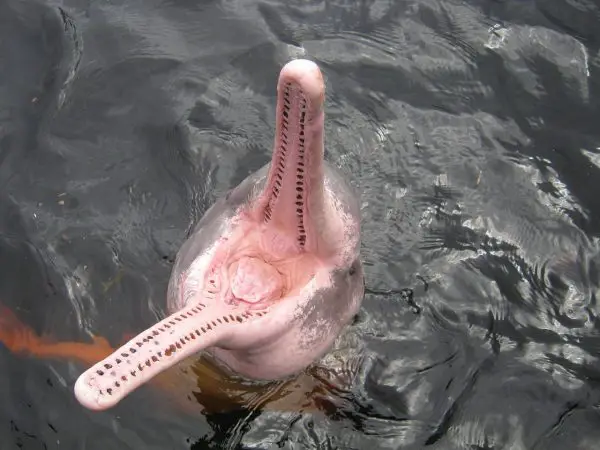Among all the aquatic animals, Dolphin is well known for its intelligence and human-friendly behavior. Kids love dolphins and are very inquisitive about them. As dolphins are mammals and they live in water, kids confuse them with fish. We have gathered a complete collection of Dolphin Facts For Kids that will answer all the questions that arise in a kids’ mind. On this page you are going to learn all about dolphins, what are they, how they look, their color, classification, species, weight, length, lifespan, special features, body parts, teeth, brain, intelligence, diet, habitat, prey, predator, adaptations, behavior, hunting techniques, echolocation, communication, lifecycle, baby dolphin and many other interesting facts about dolphins for kids along with pictures, slideshows, and videos.
Dolphin Facts For Kids
1. What Is A Dolphin – Is A Dolphin A Fish
- Dolphin is a common name of 40 extant (existing or living) species of aquatic mammals.
- They are warm-blooded and highly intelligent.
- Dolphins belong to the infraorder Cetacea.
- It includes the families;
- Delphinidae, which are known as the oceanic Dolphins
- Pontoporiidae, the brackish dolphins
- Platanistidae, dolphins of the Indian River
- Iniidae, dolphins of the new world river
- Lipotidae, the extinct dolphins of the Chinese River or baiji
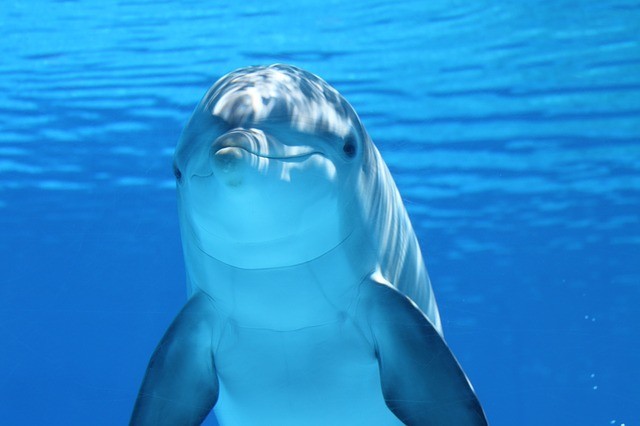
2. What Do Dolphins Look Like – Dolphin Appearance – Dolphin Description
- There are about 42 different species of dolphins and all have a somewhat different appearance.
- Dolphins have a streamlined and long body structure to move fast underwater.
- They have an average body length of 8 to 9 feet and body weight from 190 to 260 kg.
- However, members of different species might have different body sizes.
- Most dolphins have two arms like fins, a fin on the back, and a tail that split into two flukes.
- Their usual body color ranges from grey, blue, or brown. However, some species also have spots or stripes on the skin, such as killer whales.
3. What Color Are Dolphins
- Dolphins have commonly grey body colors with a whitish belly.
- However, their body color ranges from grey-blue to brownish.
- Some dolphin species also have stripes or spots on their body, such as killer whales and Atlantic spotted dolphins.
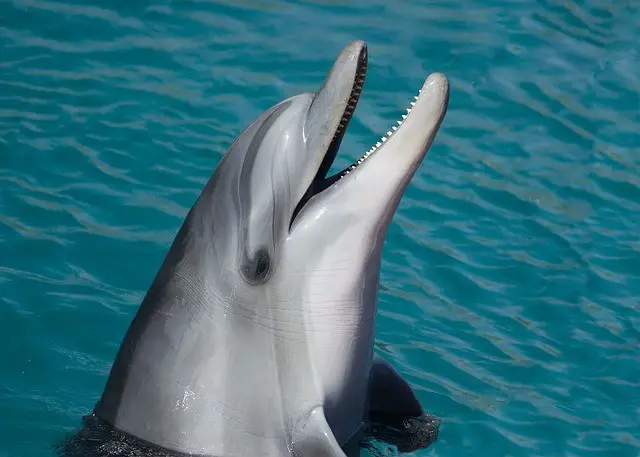
4. What Type Of Animal Is A Dolphin – What Kind Of Animal Is A Dolphin
- Dolphins are warm-blooded aquatic mammals.
Are Dolphins Mammals
- Yes, dolphins are mammals.
5. What Makes A Dolphin A Mammal – Why Are Dolphins Mammals
- Dolphins are mammals because:
- They breathe air and have lungs as their respiratory apparatus
- They give birth to young ones rather than laying eggs like fish
- The baby dolphins are nourished by mothers milk
- Baby dolphins have hair in the form of whiskers (long projecting hair) on their upper jaw which falls out after birth.
6. Is A Dolphin A Carnivore – Are Dolphins Carnivores
- Yes, all the dolphin species are carnivores because they feed on the flesh or meat of other aquatic animals.
7. Dolphin Classification
- The following is the scientific classification of dolphins:
| Kingdom | Animalia |
| Phylum | Chordata |
| Sub-phylum | Vertebrata |
| Class | Mammalia |
| Order | Artiodactyla |
| Infraorder | Cetacea |
| Parvorder | Odontoceti |
| Groups included |
|
| Groups cladistically
(clade refers to a group in the biological classification) included but traditionally not included |
|
8. Dolphin Family
- Dolphins belong to the following 5 families:
- Platanistidae
- Iniidae
- Lipotidae 9. Pontoporiidae
- Delphinidae, which are known as the Oceanic Dolphins
9. Kinds Of Dolphins – Dolphin Species – How Big Are Dolphins – Dolphin Size – How Long Do Dolphins Live – Dolphin Lifespan
- The following table shows all the 44 dolphin species along with their body size and lifespan:
| S.No | Dolphin Species | Body Length
(m) |
Body Weight
(kg) |
Estimated Lifespan
(years) |
| 1 | Killer Whale or Orca | 6 to 8 | 3,600 to 5,400 | 29 |
| 2 | Common Bottlenose Dolphin | 2 to 4 | 150 to 650 | 40 |
| 3 | Amazon River Dolphin | 2.5 | 185 | 18 |
| 4 | Striped Dolphin | 2.6 | 160 | 55 to 60 |
| 5 | Spinner Dolphin | 1.3 to 2.3 | 23 to 79 | 20 to 30 |
| 6 | Baiji | 2.3 | 135 to 230 | 22 |
| 7 | Short-Beaked Common Dolphin | 1.5 to 2.5 | 100 to 136 | 35 |
| 8 | Indian Ocean Humpback Dolphin | 2.0 to 2.8 | 150 to 200 | 40 |
| 9 | Short-finned Pilot Whale | 5.5 | 1,000 to 3,000 | 45 |
| 10 | Pacific White-Sided Dolphin | 2.3 to 2.5 | 150 to 200 | 46 |
| 11 | Irrawaddy Dolphin | 2.3 | 90 to 200 | 30 |
| 12 | Pantropical Spotted Dolphin | 2.5 | 120 | 40 |
| 13 | South Asian River Dolphin | 1.5 | Unknown | 26 |
| 14 | Commerson’s Dolphin | 1.5 | 23 kg | 10 (in the wild), 18 (in captivity) |
| 15 | Hector’s Dolphin | 1.2 to 1.6 | 40 to 60 | 15 to 18 |
| 16 | False Killer Whale | 4.9 | 1,200 | 58 to 63 |
| 17 | Long-Beaked Common Dolphin | 1.9 to 2.5 | 80 to 235 | 40 |
| 18 | Atlantic Spotted Dolphin | 2.2 | 140 | 30 to 40 |
| 19 | Dusky Dolphin | 1.6 to 1.7 | 70 to 85 | 20 to 25 |
| 20 | Indo-Pacific Bottlenose Dolphin | 2.6 | 290 | 35 to 50 |
| 21 | Risso’s Dolphin | 3 | 390 | 20 to 30 |
| 22 | Tucuxi Dolphin | 2.1 | 54 | 35 |
| 23 | Chilean Dolphin | 1.7 | 45 | 20 |
| 24 | Australian Snubfin Dolphin | 2.1 to 2.7 | 90 to 181 | 30 |
| 25 | Long-finned Pilot Whale | 5.7 | 800 | 45 |
| 26 | Hourglass Dolphin | 1.8 | 90 to 120 | 46 |
| 27 | Rough-toothed Dolphin | 2.1 to 2.8 | 90 to 160 | 25 to 35 |
| 28 | White-beaked Dolphin | 2.3 to 3.1 | 180 to 350 | 40 |
| 29 | Melon-headed Whale | 3 | 200 | 20 to 30 |
| 30 | La Plata Dolphin | 1.6 to 1.8 | 50 | 20 |
| 31 | Atlantic White-sided Dolphin | 2.5 to 2.8 | 200 to 230 | 22 (males), 27 (females) |
| 32 | Pygmy Killer Whale | 2.0 | 170 | 14 |
| 33 | Fraser’s Dolphin | 2.75 | 200 | 18 |
| 34 | Southern Right Whale Dolphin | 1.8 to 2.9 | 60 to 100 | Unknown |
| 35 | Heaviside’s Dolphin | 1.8 | 75 | 20 |
| 36 | Guiana Dolphin | 2.1 to 2.2 | 60 | Unknown |
| 37 | Northern Right Whale Dolphin | 2 to 3 | 100 to 110 | 42 |
| 38 | Clymene Dolphin | 2 | 75 to 80 | Unknown |
| 39 | Peale’s Dolphin | 2.1 | 115 to 120 | 25 |
| 40 | Bolivian River Dolphin | 2.8 | 180 | Between 10 and 30 |
| 41 | Burrunan Dolphin | 2.3 to 2.8 | 150 to 200 | Unknown |
| 42 | Indus River Dolphin | 2.5 | 70 to 110 | 28 |
| 43 | Araguaian River Dolphin | 1.8 to 2.4 | 84 to 161 | Unknown |
| 44 | Australodelphis Mirus (extinct) | Unknown | Unknown | Unknown |
10. Dolphin Features – Dolphin Characteristics
- All dolphins have the following common characteristics:
- Smooth and rubbery skin
- Two fins on the sides and one fin on the back
- Communication through several types of sounds
- All dolphin species are extremely social and live in groups
- Intelligence
11. How Much Does A Dolphin Weigh – Dolphin Weight
- Of all the 43 species of dolphins, Killer Whale or Orca is the heaviest dolphin species with a bodyweight of 3,600 to 5,400 kg (7,936 to 11905 Ibs).
- While the Commerson’s dolphin is probably the smallest dolphin species the adult individuals of which have a bodyweight of up to 23 kg (50 Ibs).
12. How Long Is A Dolphin – Dolphin Length
- The body length of the smallest dolphin species ranges from 1.3 to 1.5 meters.
- While that of the largest species (Killer Whale or Orca) ranges from 6 to 8 meters.
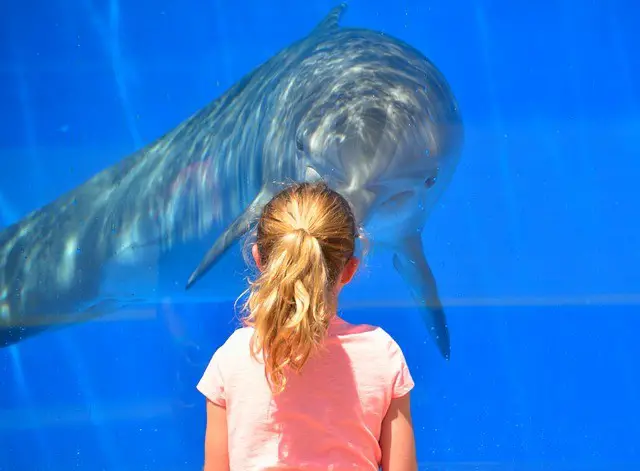
13. Dolphin Special Features
- Some of the special features of dolphins include:
- All dolphins have a round organ on their head known as “Melon”, which they used for echolocation.
- Most species have an elongated jaw structure that gives a beak-like appearance to their mouths.
- Dolphins have an extremely complex and large brain and of a different structure from many of the land mammals’ brains.
- Like other mammals, dolphins are warm-blooded and have an internal body temperature of around 36 °C.
- Dolphins have a blowhole, a respiratory organ through which they breathe.
- They are extremely social and live in groups called “pods”.
- Dolphins are also very intelligent creatures and demonstrate complex play behavior, self-awareness, and cross-species cooperation.
14. Dolphin Body Parts
Dolphins have the following body parts that are generally common to all dolphin species:
-
Fins
Dolphins have two fins, one on each side, called the pectoral fins. They also have a dorsal fin of usually triangular shape on their back. Their tail also has two fins called flukes. Dolphins use their pectoral fins like steering, while their dorsal fin provides them stability and works like the keel on a boat. Dolphins’ tail propels their body in water to move forward, upward, and downward within the water.
-
The blowhole
It is the breathing organ of dolphins as they are mammals and have lungs as their respiratory system. The blowhole is situated at the top of their head. To breathe, dolphins come to the water’s surface.
-
Blubber
It is a fatty layer under the skin of dolphins. It works as an insulator and keeps their body temperature constant within cold and hot water.
-
Rostrum
It is a snout of dolphins. It contains teeth that they used for grabbing prey. Some dolphin species, like bottlenose dolphins, have a long rostrum which they also use for probing the ocean floor.
-
Melon
It is the large and fatty forehead of the dolphins. Dolphins use their melon to produce many kinds of noises for communication and echolocation within the water.
- Just like terrestrial carnivores, dolphins have a two-chambered stomach with Fundic and Pyloric chambers.
- All dolphin species have internal reproductive organs that lie inside their bodies.

15. Do Dolphins Have Teeth – Dolphin Teeth Facts
- Dolphins have teeth of conical shape and equal size.
- Their teeth occur on both lower and upper jaws.
- Dolphins have only one set of teeth during their life and never renew when shed.
- Like other mammals, newborn dolphins also have embedded teeth in the gums and begin eruption after about five weeks of their birth.
- The average number of teeth in dolphin species is approximately from 80 to 100.
- Among all dolphin species, the long-beaked common dolphin (Delphinus capensis) has the largest number of teeth, which is up to 240.
- While the Risso’s dolphin (Grampus griseus) has the smallest number of teeth that is between 4 and 14.
- Bottlenose dolphins have 80 to 100 teeth.
- The number of teeth in the Amazon river dolphins is between 100 to 140. Along with conical teeth at the front, they also have some molar-shaped teeth at the backside of their jaws, which are unique to them.
- All dolphin species have teeth but not all species utilized them for tearing or eating the prey.
- Dolphins swallow food as a whole without chewing and mostly used their teeth to grab and secure the fast-moving prey.
How Many Teeth Do Dolphins Have
- The average number of teeth in dolphin species is approximately from 80 to 100.
- The largest number of teeth is 240 in long-beaked common dolphin (Delphinus capensis) while the most minor number of teeth is between 4 and 14 in Risso’s dolphin (Grampus griseus).
Dolphin Teeth Pictures
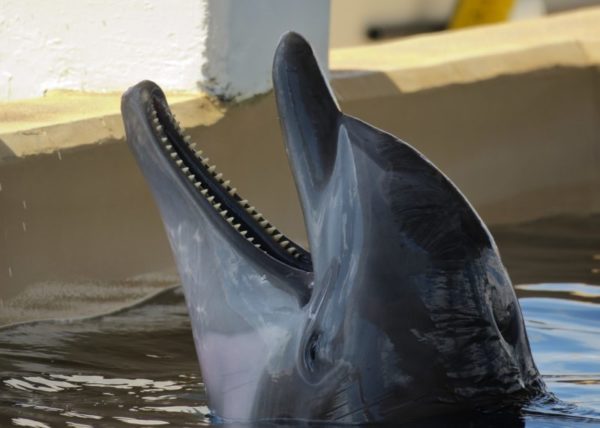
16. What Is The Nose Of A Dolphin Called
- In some dolphin species, the upper and lower jaws form an elongated structure which is called a Rostrum or snout.
- Generally, the rostrum is said as the dolphin’s nose, however, their functional and real nose is the blowhole through which they inhale and exhale air.
- The blowhole is located at the top of their heads and when open, the nasal septum (a cartilaginous partition that separates the right and left airways) became visible.
17. Dolphin Brain Facts
- Among all animal species, dolphins have the second most complex and powerful brain (after the human brain).
- The killer whale or orca has the largest brain in all cetaceans with 6,000 grams weight while the second-largest brain is of the bottlenose dolphin with up to 1,500 grams weight (humans have up to 1,200 grams weight of their brain).
- The more complex and convoluted brain of dolphins as compared to any other animal species is associated with their intelligence.
- The brain of dolphins has two hemispheres that are composed of four lobes (the human brain has three lobes).
- Their all senses are situated at the fourth lobe (while that of humans are situated in all the three lobes).
- Regarding their cognitive ability, the location of all senses in one lobe indicates that dolphins are capable to reduce the difficulty of a situation faster than humans.
- Dolphins are quick learners and talented mimics and are known for demonstrating empathy, self-awareness, innovation, and problem-solving.
18. Dolphin Intelligence Facts – Interesting Facts About Dolphins Intelligence
- Intelligence is the cognitive ability of a creature to learn and apply knowledge.
- Dolphins’ intelligence is associated with their very complex and convoluted brain that have four lobes, arranged in two hemispheres.
- Dolphins have their own extremely complicated language system.
- Their language has been appeared to be more universal, and unlike humans, they do not have any language barrier.
- They are capable of expressing their feelings and reactions and understanding the feelings of others.
- To communicate with each other, they produce a wide range of noises.
- Every dolphin also has a specific signature whistle, which is equivalent to its name.
- They can remember the signature whistle of each other even after the separation of as much as 20 years.
- Dolphins can transfer and receive information with several sound-producing organs 20 times more effective than the amount that humans can through ears.
- They can understand human language and are known to understand many words and respond to specific human gestures. They can associate a part of their body with that of a human and are observed waving their fin whenever a trainer waves his hand.
- Unlike most of the animal species, dolphins have the ability of self-awareness. In front of a mirror, they are known to recognize themselves and the mirror.
- Dolphins are well-known for their playful nature and also demonstrate teaching skills, innovation, joy, and grief.
19. Do Dolphins Have Hair
- As dolphins are mammals, having body hair is the defining characteristic of mammals.
- So dolphins should have hair on their bodies, which is not observed in their smooth and streamlined body.
- When dolphins are born they have hair on the skin of their upper jaw.
- But soon after birth, the hair falls out and only the hair follicles remain in the form of tiny pockmarks.
- Dolphins do not need hair on the body to survive, as they have blubber (a thick fatty layer) just beneath their skin, which provides insulation in the cold and hot waters of the ocean.
20. Dolphin Diagram

21. What Do Dolphins Eat – Dolphin Diet
- Dolphins are carnivores in nature.
- They are active predators and feed on the flesh of a variety of aquatic creatures.
- Each dolphin species have a different diet, which ranges from large marine mammals to small fish and aquatic crustaceans (such as shrimp, prawns, krills, etc).
- Dolphins swallow food as a whole without chewing.
- They usually use their teeth only to grab their prey and swallow it from the head side as a whole.
- If the prey is large, they tear it apart into small pieces either through shaking or rubbing with something.
- The everyday diet of an adult dolphin is approximately 5% of its entire body weight, while that of a nursing female is approximately 8% of its whole body weight.
- The stomach of dolphins has several chambers, which make the digestion of food quick and faster.
22. What Are Dolphins Prey – Dolphin Prey
- The prey of dolphins includes a wide range of bony fishes, aquatic crustaceans, and cephalopods.
- Dolphins living in the open waters mostly prey on fish and squids.
- While dolphins living in the coastal regions prey on fish and bottom-dwelling creatures.
- Their favorite prey is:
-
- Herrings
- Atlantic mackerel
- Cod
- Squid
- Shrimps
- Octopus
- Mullets
- Among all dolphin species, the Orca or Killer Whale is an exceptional case, which hunts marine mammals and birds along with small-sized fishes.
- The prey of Orca includes sea lions, dugongs, seals, walruses, juvenile as well as injured and old baleen whales, penguins, and other sea birds.
How Do Dolphins Hunt – Dolphin Hunting Facts
- Dolphins use the following different hunting techniques to catch their prey:
- Bait Ball: dolphin pods squeeze a herd of fish to a small volume, called a bait ball, and then turn and plow through it.
- Mud circles: dolphins make mud circles in shallow waters through their tail. The mud circle acts as a mud net and squeezes a large amount of fish on which the dolphins finally feed.
- To catch flying fish, dolphins follow their flying patterns just below the water surface. Whenever the fish plop back into the water, the dolphin is ready to capture it.
- Dolphins often chase their hunt into beaches and mud banks through the creation of wave pressure, where they then hunt it easily.
- Sometimes, dolphins hit the water surface through their tail fluke. It sent shock waves and the fish become stunned and confused, which then dolphin hunt very easily.
- Dolphins also sometimes use their powerful sonars to find hidden fishes in the sand, which they then pull out and eat.
- When a hunt is too big for a dolphin to eat, they break it into pieces by grabbing with their tail and slamming against the water surface.
Bottlenose Dolphin Food Chain
- The bottlenose dolphin is part of the oceanic food chain.
- The following food chain shows the energy transfer between a bottlenose dolphin and specific plants and animals that depend on each other.
- Phytoplankton gets energy from the sun.
- Zooplankton eats phytoplankton.
- Krills eat zooplankton as their diet.
- Squids then consume krills.
- Large fish eat squids as well as krills.
- Bottlenose dolphin consumes fish and squids.
- Killer whales and sharks are the predators of the bottlenose dolphin.
- Sharks and killer whales have no predators and their bodies decompose after their death, which is then used by phytoplankton.
23. Where Do Dolphins Live – Dolphin Habitat
- Dolphins live in all the oceans of the world.
- Some of the dolphin species also flourish in the fresh waters of rivers.
- Out of 44 dolphin species, up to 38 inhabit the salty waters of the ocean while 6 species inhabit the rivers.
- Dolphins prefer the temperate and tropical waters and concentrate from the equator to the subpolar regions.
- The habitat of river dolphins include the Yangtze River, The South Asian rivers, and the Amazon river.
24. Dolphin Habitat Map – Map Of Where Dolphins Live

25. Dolphin Environment – Dolphin Biome
- Most dolphin species prefer the tropical environment of the oceans.
- However, some species live only in the environment for which they are physically adopted.
- For example, common bottlenose dolphin, short-beaked common dolphin, and Risso’s dolphin are cosmopolitan dolphin species and found worldwide.
- While the biome of Burrunan dolphins is found only in Australia and the Hourglass dolphins inhabit the Antarctic and subantarctic waters.
- The biome of some dolphin species only thrives in the freshwaters of the river like Baiji and Tucuxi, which are found only in the Yangtze River and the Tucuxi Rivers respectively.
26. What Oceans Do Dolphins Live In – Dolphin Range
- Dolphins are found worldwide in all the oceans and seas except the Caspian and Aral Seas.
- The general habitat range of dolphins in the tropical and temperate waters of the ocean.
- However, not all species of dolphins are found in all oceans, especially in the Arctic and Antarctic Oceans.
- All the dolphin species have a different habitat range, but all species usually avoid the extremely cold waters of the polar zones.
27. The Dolphin Life Cycle For Kids
- Dolphins have the same life cycle as land mammals.
- They reach sexual maturity at the age of 5 to 10 years, depending on the species they belong to.
- The gestation period varies between species. Species of small size like Tucuxi have an 11 to 12 months gestation period while the largest species Orca have up to 17 months.
- Dolphins typically bear a single calf.
- Mother fed the newborns with her milk for 18 months to 2 years, depending on the species.
- The average lifespan of dolphins is up to 30 years. However, the lifespan varies between species from 20 to 50 years.
Dolphin Life Cycle Diagram For Kids
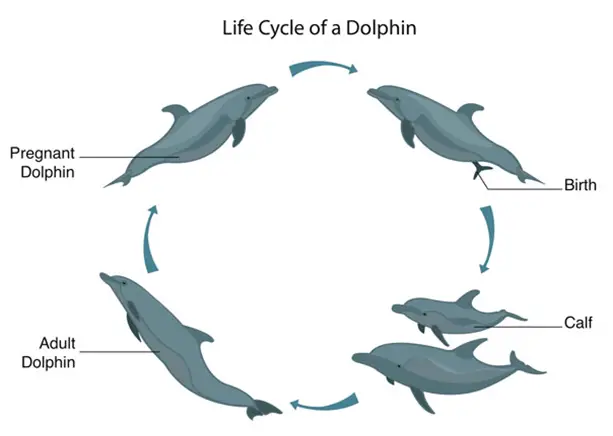
28. How Many Babies Can A Dolphin Have
- A dolphin usually has one baby at a time and very rarely has twins.
29. How Are Dolphins Born – Dolphin Birth Facts
- Unlike land mammals, the baby dolphin is born mostly “tail first”, probably to reduce the risk of drowning.
- At the time of birth, the pod members usually surround the pregnant female to protect the calf and the mother.
30. What Is A Baby Dolphin Called
- A baby dolphin is called a “calf”.
31. Baby Dolphin Facts
- A baby dolphin, which is called a calf, has a light skin color than adult individuals.
- The newborn calves have a body weight from 9 to 11 kg (20 to 25 pounds) and 2 to 3 feet body length.
- Soon after birth, the mother or other pod member pushes the baby dolphin towards the water surface to take a breath.
- After a few minutes of birth, a calf can swim and breathe and also closely follow its mother.
- Baby dolphins feed on the mother milk from 1 and a half years to 2 years, the time which varies between species.
- However, baby dolphins can start eating small fish and crustaceans at the age of 6 months.
- The calves stay with their mothers for a time, which varies from 5 to 10 years among species, until they become adults.
How Long Does A Dolphin Stay With Its Mother
- The weaning time of dolphins ranges from 6 months to 2 years between species.
- However, a baby dolphin stays with the mother for an additional time of 3 to 8 years, until it becomes sexually mature.
32. What Is A Female Dolphin Called
- A female dolphin is called a “cow”.
33. What Is A Male Dolphin Called
- A male dolphin is called a “bull”.
34. Oceanic Dolphin
- Members of the family Delphinidae are called Oceanic dolphins.
- Oceanic dolphins are widely distributed all over the world’s oceans.
- The number of described species is 38.
- Some species are big and have the common names of “whale” rather than “dolphin” like the pilot whale and killer whale.
- Their size range from the 1.7-meter length and 50 kg weight (Maui’s dolphin) to 9.4-meter length and up to 9,900 kg body weight (killer whale).
- Some species also exhibit sexual dimorphism and males have larger body sizes than females.
35. River Dolphin Facts
- River dolphins are the dolphin species that are exclusively found in freshwater or brackish water.
- River dolphins belong to four extant families:
- Platanistidae (the Indian dolphin)
- Iniidae (the Amazonian dolphin)
- Pontoporiidae (the brackish dolphin)
- Lipotidae (the Chinese river dolphin)
- There are six extant species of river dolphins, which are found in the South Asian rivers, Amazon river, and Chinese river.
- They are adapted to survive in the shallow and warm waters and to tolerate the strong currents of the river.
- River dolphins are of relatively smaller size as compared to Oceanic dolphins.
- Their size ranges in length from 1.5 meters (South Asian river dolphin) to 2.4 meters (Amazonian river dolphin) and in weight up to 100 kg.
- Unlike Oceanic dolphins, river dolphins have a very thin or no blubber.
- As they inhabit the muddy water of the rivers, they do not rely on their sense of vision and have an extremely well-developed hearing system.
36. Bottlenose Dolphin Facts For Kids
- Bottlenose dolphins belong to the family Delphinidae or Oceanic Dolphin.
- They are the most common individuals in this family.
- They belong to the genus Tursiops, which consists of three species:
- The common bottlenose dolphin (Tursiops truncatus)
- The Indo-Pacific common bottlenose dolphin (Tursiops aduncus)
- The Burrunan dolphin (Tursiops australis)
- They found all over the temperate waters of the world’s oceans except the Antarctic and Arctic Circle regions.
- Bottlenose dolphins are very intelligent and can use tools.
- They are very social and playful.
- The average body weight of a bottlenose dolphin is up to 300 kg (660 Ibs).
- They can reach a length of about 13 feet (4 meters).
- They can swim at a speed of 35 km (22 miles) per hour.
- The maximum jumping height of a bottlenose dolphin in the air is up to 20 feet (6 meters).

Bottlenose Dolphin Diet
- Bottlenose dolphins eat fish, shrimps, and squid.
- Groups of bottlenose dolphins often make mud rings, in which they trap their prey.
Atlantic Bottlenose Dolphin
- The common bottlenose dolphin (Tursiops truncatus) is also known as the Atlantic bottlenose dolphin.
- It is the most famous species of the Oceanic dolphin family Delphinidae.
- They are kept in captivity in marine parks and Dolphinaria.
- In the wild, they found in the warm and temperate waters of the oceans all over the world.
- Their body length ranges from 2 to 4 meters while their body weight ranges between 150 and 650 kg.
- Their jaw structure gives them an irresistible smiling appearance.
- Their lifespan is from 40 to 50 years.
- Unlike other dolphins, Atlantic or Common bottlenose dolphins have a more flexible neck. The reason is that five of their seven vertebrae are not fused.
How High Can A Bottlenose Dolphin Jump
- A bottlenose dolphin can jump up to 20 feet (6 meters) high in the air.
How Fast Can A Bottlenose Dolphin Swim – Dolphin Speed
- Dolphins usually swim at a speed of 5 to 11 kilometers per hour.
- The recorded fastest speed of a bottlenose dolphin was 29.3 km per hour (18.2 miles per hour).
37. Spinner Dolphin Facts
- Spinner dolphin (Stenella longirostris) is a member of the Oceanic dolphin family Delphinidae.
- It is a small-sized dolphin found in tropical sea waters all around the world.
- There are four subspecies of the spinner dolphin:
- The Eastern spinner dolphin (Stenella longirostris Orientalis)
- Central American or Costa Rican spinner dolphin (Stenella longirostris centroamericana)
- Gray’s or Hawaiian spinner dolphin (Stenella longirostris longirostris)
- Dwarf spinner dolphin (Stenella longirostris roseiventris)
- The Spinner dolphin is well-known for its acrobatic exhibition, in which it rotates or spins with its longitudinal axis as it jumps in the air.
- Spinner dolphin makes 2 to 5.5 spins per jump.

38. Maui Dolphin Facts
- Maui’s dolphin or popoto (Cephalorhynchus hectori maui) is a subspecies of Hector’s dolphin (Cephalorhynchus hectori).
- It is the known smallest and rarest dolphin subspecies in the world.
- Maui dolphin is found only in the sea of the western region of North Island (Te Ika-a-Maui), New Zealand.
- They have up to 50 kg of body weight with about 1.7 meters of body length.
- Their estimated latest population is 63 individuals of 1 year age.
- They have up to 20 years of lifespan.
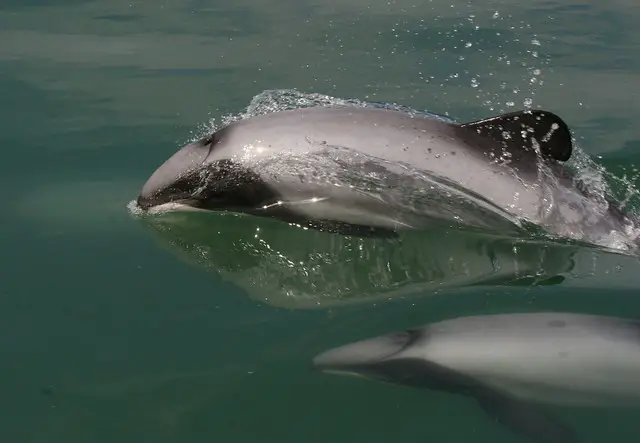
39. Striped Dolphin Facts
- Striped dolphin (Stenella coeruleoalba) is also a member of the Oceanic dolphin family, Delphinidae.
- It inhabits the tropical and temperate waters of all around the oceans of the world.
- Adult individuals have a body size of up to 2.6 meters in length and a bodyweight of 160 kg.
- Striped dolphins are very social and travel in large groups of 25 to 100.
- Their estimated population is about 2 million.
- The striped dolphin is also one of the most extensively studied dolphin species.

source: https://www.flickr.com/photos/lakpura/15355240609
40. Atlantic Spotted Dolphin Facts
- The Atlantic spotted dolphin (Stenella frontalis) is a dolphin species that inhabits only the Gulf Stream of the North Atlantic Ocean.
- Atlantic spotted dolphins are members of the Delphinidae family.
- The older individuals of this species have a distinguishing spotted coloration throughout their bodies.
- Atlantic spotted dolphins are of medium body size with up to 2.2 meters body lengths and with a bodyweight of up to 140 kg.
- They are very social and live in groups of 5 to 15 individuals.
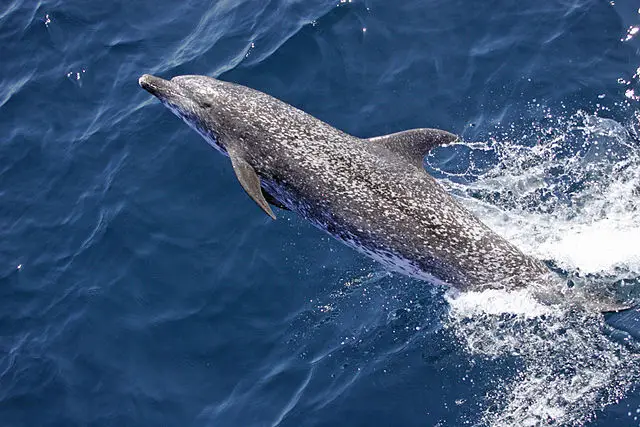
41. Amazon River Dolphin Facts – Pink Dolphin Facts
- The Amazon river dolphin (Inia geoffrensis) is a dolphin species that is also known as the Pink river dolphin.
- It belongs to the family Iniidae (a family of toothed whales).
- The Amazon or pink river dolphin is the largest dolphin species among river dolphins.
- Adult males have a maximum weight of up to 185 kg with about 2.5 meters body length.
- Pink river dolphin also has a hump on their back rather than a dorsal fin.
- Currently, there are three recognized subspecies of the Amazon or pink river dolphin;
- The Amazon river dolphin (Inia geoffrensis geoffrensis), is found in the Amazon basin.
- Bolivian river dolphin (Inia geoffrensis boliviensis) found in the upper region of the Madeira River in Bolivia.
- Orinoco river dolphin (Inia geoffrensis humboldtiana) found in the Orinoco basin.
- They have a wide range of diets and eat about 53 different species of fish along with other animals like crabs and river turtles.
- Learn more here: Amazon River Dolphin
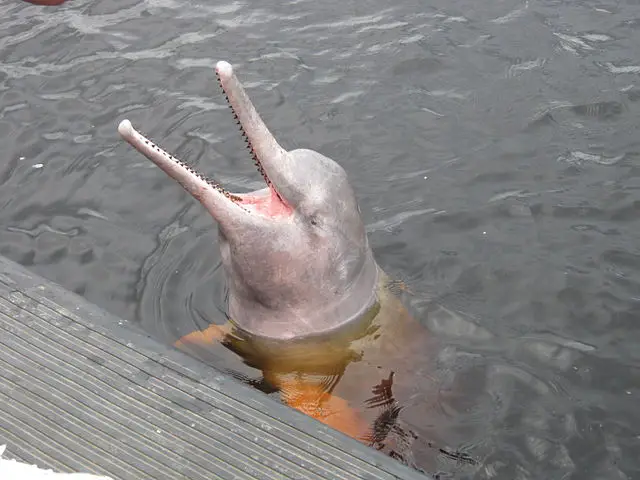
42. Baiji Dolphin Facts – Yangtze River Dolphin Facts
- Baiji dolphin (Lipotes vexillifer) is also known as the Yangtze river dolphin as well as the Chinese river dolphin.
- It belongs to a family of river dolphins Lipotidae.
- It is found only in the Yangtze River of China.
- The size of Baiji dolphins ranges from 2.3 to 2.5 meters with bodyweight between 135 to 230 kg.
- Their estimated life expectancy in the wild is up to 24 years.
- Like other river dolphins, Baiji dolphin also relays mostly on their sonar and hearing senses to navigate as they have very poor vision.
- In Chinese folklore, Baiji or Yangtze river dolphin is known as the “Goddess of the Yangtze”.
- Baiji dolphin is considered to be the first species propelled to extinction due to human activities in modern times.
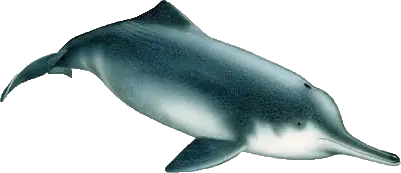
43. Dusky Dolphin Facts
- The dusky dolphin (Lagenorhynchus obscurus) is a species of the Oceanic dolphin family Delphinidae.
- Dusky dolphins are found off the coasts of Southwestern Africa, South America, Southern Australia, and throughout the waters of New Zealand.
- The body size of a population of dusky dolphins varies greatly according to their habitat.
- In New Zealand, the recorded size of dusky dolphin is between the rage of 1.67 meters to 1.78 meters body length and with the bodyweight of 69 to 78 kg.
- They live in groups of 10 to 20 individuals.
- Like other oceanic dolphins, dusky dolphins have an excellent sense of vision and have a playful nature.
- Their estimated lifespan in the wild is up to 20 years.

44. Common Dolphin Facts
- The name “Common dolphin” is given to two dolphin species, which make the genus Delphinus.
- The two species are; the short-beaked common dolphin (Delphinus delphis) and the long-beaked common dolphin (Delphinus capensis).
- Unlike bottlenose dolphin, the common dolphin is not much popular.
- It inhabits warm-temperate and tropical waters of the sea.
- The body size of an adult individual ranges between 1.9 to 2.5 meters with the bodyweight between 80 to 150 kg.
- They swim at a maximum speed of up to 60 km/h.

45. Florida Dolphin Facts
- The temperate waters of Florida with food abundance is the favorite region of dolphins to live.
- Many different species of dolphins are found in Florida.
- The most common species are bottlenose dolphin and the Atlantic spotted dolphin.
- Florida waters are also the breeding site of dolphins.
46. Dolphin Behavior Facts
- Dolphins are often considered as one of the most intelligent creatures on the planet Earth.
- Dolphins are highly social and live in groups. They are observed staying with ill or wounded individuals and helping them in breathing, and if necessary taking them to the surface. In New Zealand, a dolphin was observed guiding a female Pygmy sperm whale with her calf, who lost their way and aground in the shallow water. Dolphins are also observed forming swimming circles around the swimmers to protect them from sharks. They also sometimes impose on sharks and make them go away from the swimmers.
- Dolphins use a variety of sounds for communication. They also sometimes use nonverbal communication by making gestures and touching.
- Dolphins also use tools and transfer knowledge to their offspring.
- They are observed to engage in aggressive disputes towards each other and sometimes force the targeted dolphin to expel after losing a fight. Male dolphins also engage in infanticide behavior.
- When a female gives birth, the pod members surround the pregnant female to protect the mother and the calf. The mother or another pod member also immediately bring the calf to the water surface for a breath.
- Dolphins feed through several methods, one and the most common of which is herding. In herding, a pod pushes a large amount of fish into a small volume, called the baitball. The individual pod members then enter the ball and feed on the fish. In another method called Corralling, they chase fish into shallow waters to capture them easily.
- Dolphins also play games, show self-awareness, and exhibit grief and joy.
47. Dolphin Learned Behaviors
- Dolphins show several learned behaviors like:
- When dolphins forage in the sea grounds, they cover their snouts with sponges to protect their mouth from scratching.
- Communication through echolocation is also a learned behavior. They learn from others how to create and detect a series of voices.
- Communication via posture is another learned behavior, in which they open their jaws, bumping heads, or slap tails at the water surface.
- Chasing prey is also a learned behavior, in which they trap a large amount of fish in a small circular area (known as the baitball) and then turn into it and eat the trapped fish.
- Playing games is also a learned behavior of dolphins, which they learn through watching others. They are observed of learning many tricks in captivity.
48. Dolphin Characteristic Behavior
- The playful nature is the characteristic behavior of all dolphin species.
- Dolphins often play and chase one another. They often throw objects like seaweed to one another.
- The playful nature is an important factor in having sociality and bond between dolphins.
49. What Do Dolphins Do For Fun – What Do Dolphins Like To Do
- Dolphins like to do some activities for fun, like jumping and acrobatic spins in the air.
- They are polite creatures and encounter a new dolphin friendly.
- They are observed of friendly interacting with humans and often follow ships.
- Dolphins also like to spend time with each other and love to socialize for fun.
- For fun, they play with each other and are also observed in making love.
50. What Is A Group Of Dolphins Called – Dolphin Pod Facts
- Dolphins groups are called “Pods”.
- A pod contains an average 12 number of individuals.
- Depending on species and location, the size of pods varies greatly.
- In locations of abundant food, many pods often merge temporarily and form “Superpods”.
- Superpods may have more than 1,000 dolphins.
- Be a member of another pod is not hard for dolphins and interchange is common.
- The pod members established strong social links and perform works together like hunting and evading predators. The pod members take care of a pregnant female and her calf after giving birth. Pod members also stay with wounded or ill individuals and help them in many ways, even bringing them to the water surface for breath if needed.
51. What Are Dolphins Predators – Dolphin Predators
- Large-sized dolphin species like Orca or killer whale is an apex predator and do not have any natural predators.
- Small-sized species also do not have a wide range of predators.
- Some shark species like bull sharks, tiger sharks, dusky shark, and great white shark are the natural predators of small dolphin species and particularly of calves.
- Orca also sometimes prey on other dolphins.
52. Threats To Dolphins
- Besides predators, there are many other threats to dolphins.
- Dolphins suffer from a wide range of parasites and diseases.
- They particularly suffer from Cetacean morbillivirus, which causes the death of many hundreds of animals of various species.
- Research at the U.S. National Marine Mammal Foundation revealed that dolphins also develop type 2 diabetes.
- Human activities are a major threat for dolphins, especially for river dolphin species like the Yangtze river dolphin (Baiji), Amazon river dolphin, and the South Asian river dolphin (Ganges).
- Yangtze river dolphins now seem to be functionally extinct and a survey in 2006 found no individuals of this species.
- Drainage of pesticides, heavy metals, agricultural and industrial pollutants, and plastics are damaging the habitat and environment of both oceanic and river dolphins and are a major threat to their survival.
- Many dolphins also died due to collision with boats.
53. Dolphin Adaptations
- Dolphins have many adaptations which enable them to survive in the marine climate.
- The most important adaptation of dolphins is echolocation, through which they navigate, communicate, and locate and recognize objects.
- Dolphins have streamlined body shape due to which they face less resistance when swimming and do not consume a huge amount of energy.
- Having a blowhole on the top of their head is another adaptation of dolphins. So that they inhale and exhale quickly at the water surface.
- Dolphins can hold their breath for 10 to 12 minutes.
- Dolphins need just about 0.3 seconds to exhale and inhale.
- They regularly dive at a depth of 3 to 46 meters. Dolphins do not need much deep dive for food. Like humans, deep diving can also exert negative physiological impacts on dolphins.
- Dolphins have several thermoregulatory strategies, due to which their body temperature remains constant. They have blubber (a thick layer of fat) just beneath their skin which prevents heat loss. Their circulatory system adjusts as well as conserves heat.
- When dolphins sleep, half of their brain stay alert and conscious in order to take a breath and protect itself from threats.
54. Dolphin Echolocation Facts – Dolphin Sonar Facts
- Echolocation is a biological sonar, which dolphins and several other animal species use to identify and locate objects.
- Echolocation is also known as biosonar.
- Dolphins emit a series of low and high-frequency sounds that transmitted to the environment through their fatty forehead, known as the melon.
- When the sound waves hit an object, it reverberates.
- If the distance is greater, it will take more time to return.
- When dolphin receives the reflected sound signals, an image is formed in their mind about the location, size, and speed of the target.
- The sonar of dolphins is a composition of several parts, each one is designed for a particular function.
- Dolphins do not have any vocal card and still, they produce a wide range of voices. They make sounds through the airflow.
- When a dolphin exhales and then inhale air at the water surface, the blowhole close tightly at the time when they re-enter to water.
- The inhaled air moves through the nasal passages, and in the way of airflow to the lungs, sounds are produced through the air sacs in their head when air flows through it.
- Dolphins can produce sounds of an extremely higher frequency of 120 kHz.
- Dolphins navigate, protect themselves, locate prey and hunt through echolocation.
- The time, intensity, and pitch of echoes provide information to dolphins about the distance, direction, size, position, and composition of objects.
- Even in murky waters and in dark, dolphins do not need a sense of vision to communicate and to locate prey and predators.
55. Dolphin Communication Facts
- Dolphins communicate through a wide range of sounds.
- Through the first year of life, each dolphin develops a specific and distinctive sound, which is unique for every individual.
- This unique sound is like their name through which they identify each other.
- Besides sounds, dolphins also communicate through nonverbal gestures, body language, and touch.
56. Dolphin Hearing Facts
- Unlike humans and other land-mammals, dolphins do not have external ears.
- They receive sound waves through their throat, which pass to the inner ear through fat-filled cavities.
- Dolphins have an isolated hearing system from the skull, which enables them of greater underwater directional hearing.
- They have the ability to listen to a wide range of sound frequencies, from 20 Hz to 150 kHz.
57. How Long Can A Dolphin Live Out Of Water – How Long Can Dolphins Survive Out Of Water
- Out of the water, a dolphin can survive for several hours, if it remains wet in a suitable temperature.
58. How Do Dolphins Breathe Underwater – Dolphin Breathing Facts
- A dolphin is a mammal and has lungs for respiration.
- The breathing organ of dolphins is the blowhole located at the top of their head.
- A muscular flap covers the blowhole as a watertight seal.
- When dolphins are underwater, they hold their breath.
- Just before reaching the water surface, dolphins contract their muscular flaps and open the blowhole to start exhalation.
- They then inhale quickly at the water surface and close the blowhole through relaxing the muscular flaps.
- Dolphins exchange more than 80% of their lung air during a single breath.
- The exhalation and inhalation process takes place only in about 0.3 seconds.
- A dolphin breathes 1.5 to 4 times in one minute.
- The inhaled air recycles within their respiratory system, due to which dolphins can hold their breath underwater for 10 to 12 minutes.
59. Do Dolphins Sleep
- Yes, dolphins sleep.
- But unlike humans, they never fall completely asleep and can not be caught napping, especially in the wild.
- In dolphins, half part of their brain sleeps while the other half stays awake and alert. This kind of sleep is known as Unihemispheric Slow-wave Sleep.
- The awake part of the brain monitors the surrounding environment for possible predators and ensure breathing.
- In captivity, dolphins are observed of fully asleep with both eyes closed and not responding to external stimuli.
- In such a case, their respiration becomes automatic and through a tail kick reflex, the blowhole remains above the water surface if needed.
60. Dolphin Fish Vs Dolphin Mammal
| Dolphin Fish | Dolphin Mammal |
|
|
61. Weird Dolphin Facts
- Dolphins exhibit empathy.
- The hearing sense of dolphins is up to 7 times more sensitive than that of humans.
- Spinner and dusky dolphins can jump to a height of about 6 meters (20 feet) in the air.
- Dolphins can sleep but half of their brain stays awake.
- Scientists agree that dolphins do not dream as they never fall into full and deep sleep.
- Only one tablespoon of water in a dolphin’s lung is enough for it to be drowned.
62. Interesting Facts About Dolphins – Amazing Facts About Dolphins
- After human beings, dolphins have the second most complex and powerful brain in the animal kingdom.
- Dolphins possess the most excellent sonar system on the planet Earth, which is known as the biological sonar or echolocation.
- Every individual dolphin has a specific signature whistle, through which they recognize each other. Scientists consider their specific whistles as their names.
- In the animal kingdom, dolphins also have the most longer memory and can recognize the special whistles of each other even after the separation of about 20 years.
- Underwater, a dolphin can hold its breath for an average time of 10 to 12 minutes.
- Dolphins exchange up to 80% of their lung air during a single breath. (this amount for humans is only about 17%).
- While humans have the ability to hear sounds of 20Hz to 20kHz frequencies, dolphins can hear the sounds of 20Hz to 150kHz frequencies.
- Dolphins have the ability to recognize themselves and the mirror.
- Through echolocation, a dolphin can differentiate between two objects of diameters of 2 and a half inches and 2 and a quarter inches.
- Dolphins are capable to understand human language and are known to comprehend several hundred words and respond to specific human gestures.
- Dolphins have the natural ability to survive and recover extremely deep injuries from shark bites. Even very deep wounds do not cause excessive blood loss in dolphins that lead to death.
63. Fun Facts About Dolphins
- Dolphins are capable to understand and talk with each other over a phone call.
- In Ancient Roman civilization, dolphins were believed of bringing souls to the Islands of the Blest.
- A dolphin can produce 700 clicks in one second.
- Dolphins fulfill their water requirements from the food they eat and do not drink water.
- Dolphins also possess belly buttons, through which they were attached to their mothers in the womb.
65. Dolphin Pictures To Color


